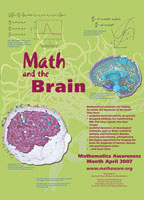Mathematics and the Brain: Celebrate Math Awareness Month April 2007
March 13, 2007

In search of possible themes for this year's Math Awareness Month, SIAM quickly identified what seemed to be a winner. According to then-president Martin Golubitsky, "Mathematics and the Brain" had the hallmarks of a worthy theme: active research on many fronts, carried out by mathematicians working with scientists, theoretical and experimental, in other fields; results already making a difference in clinical practice; the promise of even greater advances in the future, with more people poised to profit from new insights, achieved in meeting, and in turn inspiring, ever greater mathematical challenges. How could a scientifically inclined student resist?
Aesthetic reservations about the theme---an attractive poster about the brain?---rapidly dissipated when SIAM designer Lois Sellers got in touch with Chris Johnson and his colleagues at the University of Utah. Johnson, who is director of the university's Scientific Computing and Imaging Institute, uses scientific visualization in studying the brain (and much else). Johnson and other SCI researchers have developed software that allows the transformation of 2D imaging data---generated by, say, CT and MRI---into 3D images. Among the group's successes has been use of the technology to provide neurosurgeons with preoperative 3D views of their patients' brains.
In addition to help with the poster, Johnson, with Bard Ermentrout and Nancy Kopell, agreed to serve as guest editors for what would become this issue of SIAM News. We hope that it will give readers, both students and faculty, a taste for the progress being made in understanding the brain, and the role played by mathematical and computational scientists in achieving it.
Visualization and imaging are one substantial mathematical focus of brain research. Approaching the brain from a completely different direction, Ermentrout, a professor of computational biology at the University of Pittsburgh, models the behavior of networks of neurons and studies the dynamics of wave propagation. He and his colleagues have created several software packages for the study of dynamical systems. Ermentrout not only joined Johnson and Kopell in identifying research to be covered in this issue of SIAM News, and then inviting active researchers to write the articles---he also wrote one himself (with experimental neuroscientist David Pinto of the University of Rochester). Among the researchers who have worked with Ermentrout is Nancy Kopell, the third of our guest editors and, as this year's John von Neumann lecturer, the subject of the article by SIAM News contributing editor Michelle Sipics.
Oscillations associated with cognition, as Kopell told Sipics, have been her obsession during the past decade. As their articles make clear, the contributors to this issue share Kopell's passion, and her optimistic view of a future of advances that carry with them boundless fascinating new research questions.
SIAM News sincerely thanks the three guest editors and all the contributors. We hope that their enthusiasm will prove infectious!
Mathematics Awareness Month, celebrated each year during the month of April, is sponsored by the Joint Policy Board for Mathematics (made up of four member organizations: the American Mathematical Society, the American Statistical Association, the Mathematical Association of America, and SIAM). Posters for Math Awareness Month 2007 were sent to U.S. academic departments; the poster and other material can be found at www.mathaware.org. The articles from this issue of SIAM News are posted at the site, in some cases significantly enhanced by the availability of color for the illustrations.

